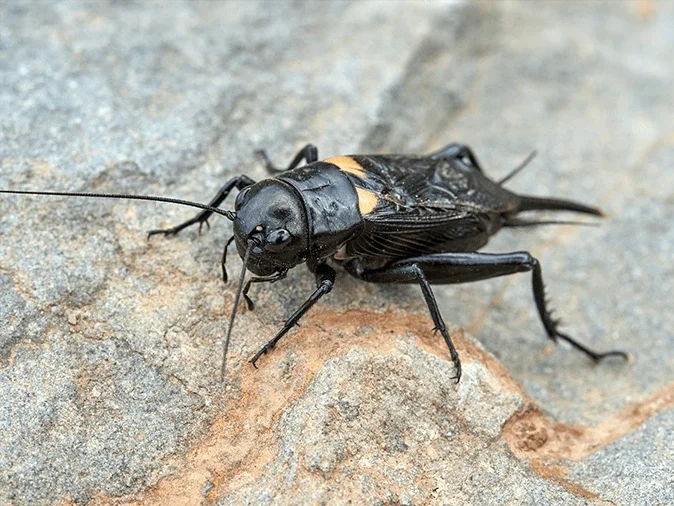
What Do Field Crickets Look Like?
Field crickets are approximately 1/2 to 1 1/4 inches long and are usually black in color and have thicker bodies. Their hind legs are longer than the front ones. Males have a sharp ridge on one wing called a scraper, and wrinkles on the other called a file. He rubs these together to make the chirping sound used for mating and to communicate danger.
Openings on the front legs serve as ears as crickets sense vibrations.
When are field crickets most active?
Life Cycle of Field Crickets
Gradual metamorphosis
Crickets have a lifespan of one year. They lay eggs in late fall after mating. The female places eggs in soil or cracks and crevices using a tube called an ovipositor. The eggs hatch in the spring when young emerge.
The young look similar to adult forms and are capable of walking, running and jumping. The young go through a series of molts before becoming adults.
Females go through 9 molts and males through 10. This process takes 65-102 days.
Habits of Field Crickets
- Diet: Omnivores eating plants as well as insects.
- Activity: Nocturnal. More active in warm temperatures
- Preferred Climate: Temperate climates
- Defense: Warning chirps.
- Cautions: Can be destructive to crops, clothing and other textiles. Chirping sound can be a nuisance.
- Home Invasion: Occasionally invade homes especially in the fall when the home provides a warmer environment. Will hide in cracks and crevices until nighttime.
Are Field Crickets Dangerous?
Field crickets are considered a nuisance pest especially when they emit the chirping sound.
They are not harmful to humans, but may damage crops as well as clothing and other textiles.
Where Do Field Crickets Nest?
Field crickets are often found in moist areas where water accumulates.
Helpful Hints for Field Crickets
Try reducing night lighting or switching to yellow lights to make your property less appealing to field crickets. We also encourage property owners to sign up for home pest control.
An Interesting Fact About the Field Cricket
In the Orient, the sound of a singing cricket inside a home is considered a thing of beauty.
How Do You Get Rid of Field Crickets?
If you’ve discovered crickets in your home, contact Northwest Exterminating for the best home pest control in the Phoenix and Tucson metros. Our team would be happy to help you take care of this nuisance pest problem!

Testimonials
Request Your FREE Estimate
Have questions or need help getting rid of field crickets or other pests? Simply complete the form below or give us a call!



